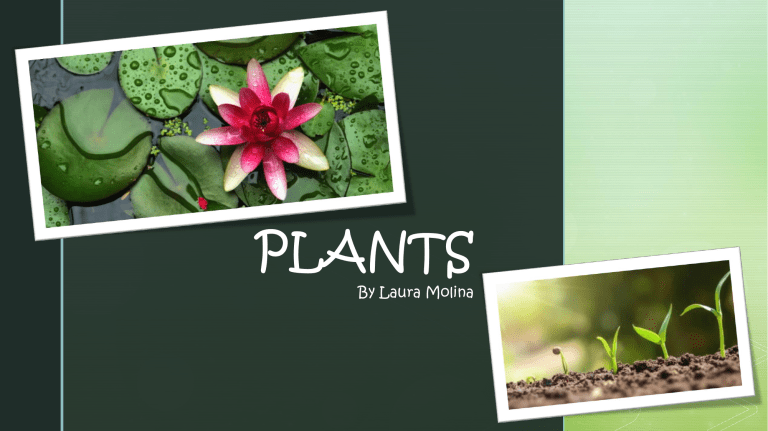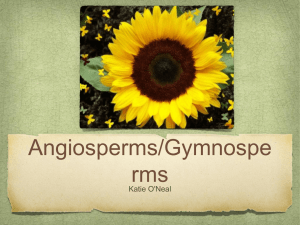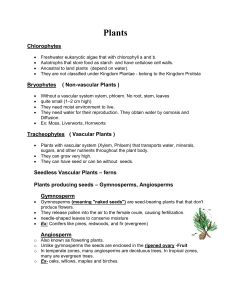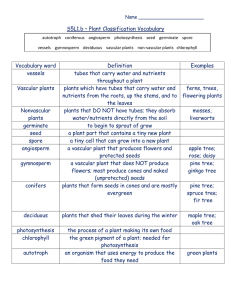
z PLANTS By Laura Molina z Everywhere you see, you see a green cover, with different types of plants and trees. Plants and plant products are something very familiar that you use in your everyday life. But, have you ever wondered about the different types of plants and trees? Did you know that the Plant Kingdom is divided into several subgroups, with each one having special features? Delve into the depths of Kingdom Plantae and unearth some of the fascinating facts. z These living organisms are made of eukaryotic cells and are multicellular. The cells have a cell wall which is made of cellulose. These are autotrophic and synthesize food by photosynthesis due to the presence of chloroplasts. z EUKARYOTIC CELLS Eukaryotic cells are cells that contain a nucleus and organelles, and are enclosed by a plasma membrane. Organisms that have eukaryotic cells include protozoa, fungi, plants and animals. z MULTICELLULAR All species of animals, land plants and most fungi are multicellular, as are many algae, whereas a few organisms are partially uni- and partially multicellular, like slime molds and social amoebae such as the genus Dictyostelium. z CELL WALL A cell wall is a structural layer surrounding some types of cells, just outside the cell membrane. It can be tough, flexible, and sometimes rigid. It provides the cell with both structural support and protection, and also acts as a filtering mechanism. z CELLULOSE Cellulose is an organic compound with the formula, a polysaccharide consisting of a linear chain of several hundred to many thousands of linked D-glucose units.Cellulose is an important structural component of the primary cell wall of green plants, many forms of algae and the oomycetes. Some species of bacteria secrete it to form biofilms. z AUTOTROPHIC An organism capable of synth esizing its own food from inor ganic substances, using light o r chemical energy. Green plant s, algae, and certain bacteria a re autotrophs. z PHOTOSYNTHESIS Photosynthesis is a chemical reaction that takes place inside a plant, producing food for the plant to survive. Carbon dioxide, water and light are all needed for photosynthesis to take place. Photosynthesis happens in the leaves of a plant. zBased on whether plants have a well-differentiated body and the presence or absence of specialized tissues for transport, and the ability to bear seeds Kingdom Plantae (Plant Kingdom) is can be classified into different divisions. The features and examples of each division are mentioned hereunder. z DIVISION THALLOPHYA These are the lowermost plants of the plant kingdom, without a well-differentiated body design. This means that the plant body is not differentiated as roots, stem, and leaves. They are commonly called algae, are permanently aquatic. Examples include Spirogyra, Chara, and Ulothrix. z DIVISION OF BRYOPHYTYPES Bryophytes are an informal group consisting of three divisions of non-vascular land plants (embryophytes): the liverworts, hornworts and m osses.[1] They are characteristically limited in size and prefer moist habitats although they can survive in drier environments.[2] The bryophytes consist of about 20,000 plant species. z PTERIDOPHYTE DIVISION A pteridophyte is a vascular plant (with xylem and phloem) that disperses spores. Because pteridophytes produce neither flowers nor seeds, they are sometimes referred to as "cryptogams", meaning that their means of reproduction is hidden. Ferns, horsetails (often treated as ferns), and lycophytes (clubmosses, spikem osses, and quillworts) are all pteridophytes. z DIVISION PHANEROGAMAE Phanerogams are seed-bearing plants. The plant body is well differentiated with stem, leaves, and roots. There are well differentiated reproductive tissues that produce seeds. These plants also have a well-developed vascular system. Depending on whether the seeds produced are naked or whether they are enclosed, phanerogams are further classified into two subdivisions. They are Gymnosperms and Angiosperms. z GYMNOSPERMS Gymnosperms are plants with naked seeds. There are about 650 living species of gymnosperm plants. The plants are usually perineal, evergreen and woody. They have a welldeveloped vascular tissue but do not have vessels. The reproductive organs generally form cones or strobilus. There is no fruit formation and the seeds are hence said to be naked. Examples: Cycas, Pinus, Deodar. ANGIOSPERMS z Angiosperms are seed-bearing plants. Seeds develop inside tissues that get modified to form the fruit of the plant. Also called the flowering plants, they are found abundantly in nature. These plants are usually terrestrial and they may be annual, biennial or perennial. The vascular system is very well developed with xylem and phloem. Angiosperms also show the feature of double fertilization. Examples: Mustard plant, Pea plant. On the basis of the cotyledons (seed leaves) Angiosperms are further divided into Monocotyledonous plants and Dicotyledonous plants. Monocots have seeds with single seed leaf, having vascular bundles arranged in a complex manner. Dicots, on the other hand, have two cotyledons. The vascular bundle is arranged in a ring.






